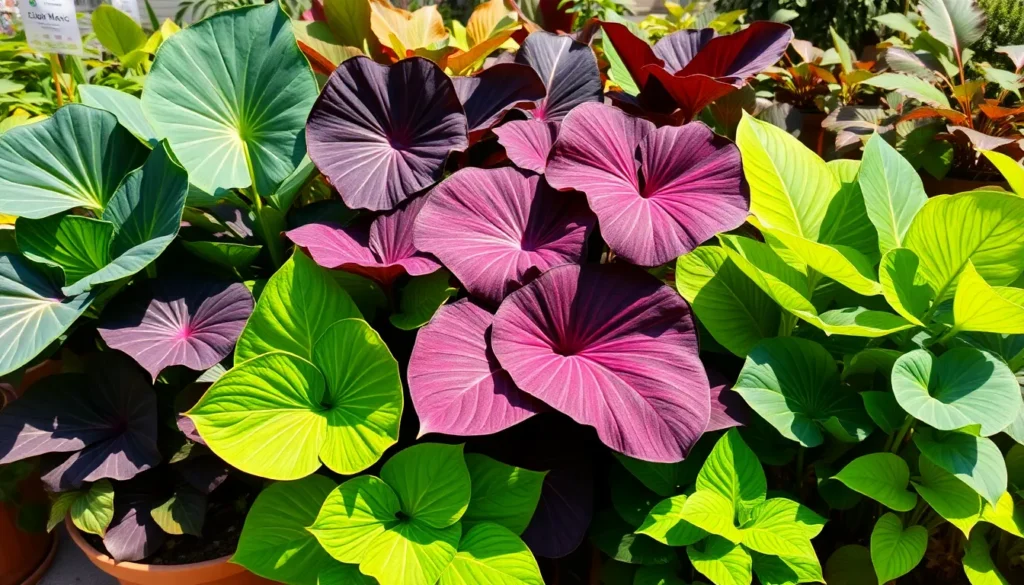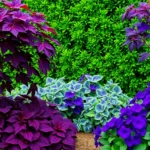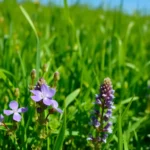We’ve all admired those stunning tropical plants with massive heart-shaped leaves that instantly transform any garden into a lush paradise. Elephant ear plants have captured gardeners’ hearts worldwide with their dramatic foliage and impressive size that can reach several feet tall.
What many don’t realize is there’s an incredible variety of elephant ear species and cultivars available today. From the classic green giants to vibrant purple varieties and even striking black-leafed specimens we’re seeing more diverse options than ever before. Each variety brings its own unique characteristics in terms of leaf color patterns size and growing requirements.
Whether you’re a seasoned gardener looking to expand your tropical collection or a beginner drawn to these show-stopping plants we’ll explore the most popular elephant ear varieties that can elevate your industry. Understanding the differences between these varieties will help you choose the perfect specimens for your exact growing conditions and design goals.
Colocasia Esculenta: The Classic Elephant Ear Variety
Colocasia esculenta stands as the most recognized elephant ear species, offering gardeners reliable performance and stunning foliage displays. We’ve cultivated many varieties within this species that showcase exceptional adaptability to various growing conditions.
Black Magic Colocasia
Black Magic transforms gardens with its dramatic deep purple to nearly black foliage that creates striking contrast against green plantings. We recommend this variety for gardeners seeking bold focal points since its leaves can reach 2 feet in length and maintain their dark coloration throughout the growing season.
Growing Black Magic requires partial shade to full sun exposure, though we’ve observed better color retention in locations receiving morning sun and afternoon shade. This cultivar thrives in consistently moist soil and reaches mature heights of 3 to 4 feet, making it perfect for middle border plantings or container gardens.
Key Growing Requirements:
| Aspect | Requirement |
|---|---|
| Sun Exposure | Partial shade to full sun |
| Soil Moisture | Consistently moist |
| Mature Height | 3-4 feet |
| Leaf Size | Up to 2 feet long |
| Hardiness Zone | 8-11 |
Royal Hawaiian Series
Royal Hawaiian varieties deliver exceptional performance with their glossy leaves and vibrant color combinations that enhance tropical garden themes. We’ve grown multiple cultivars from this series including ‘Blue Hawaii’, ‘Pink China’, and ‘Lime Zinger’, each offering unique leaf patterns and colorations.
‘Blue Hawaii’ produces striking blue green leaves with dark purple stems, while ‘Pink China’ showcases green foliage with pink veining and petioles. These varieties typically reach 18 to 24 inches in height, making them suitable for container cultivation or front border plantings.
Establishing Royal Hawaiian varieties requires well draining soil enriched with organic matter and regular watering during active growth periods. We’ve found these cultivars perform best in partial shade conditions where they receive 4 to 6 hours of filtered sunlight daily.
Coffee Cups Cultivar
Coffee Cups stands out among colocasia varieties with its distinctive cupped leaf shape that resembles coffee cups turned upward, creating unique water catching formations. We appreciate this cultivar’s compact growth habit that reaches only 12 to 18 inches in height while producing leaves up to 8 inches across.
This variety displays green foliage with prominent dark veining that becomes more pronounced as leaves mature throughout the season. Coffee Cups works exceptionally well in small gardens, rock gardens, or as accent plants in mixed containers where its unusual leaf form draws attention.
Maintaining Coffee Cups requires consistent moisture levels and protection from strong winds that might damage its delicate cupped leaves. We suggest planting this variety in locations with morning sun and afternoon shade to prevent leaf scorch while promoting healthy growth patterns.
Alocasia Species: The Upward-Facing Elephant Ears
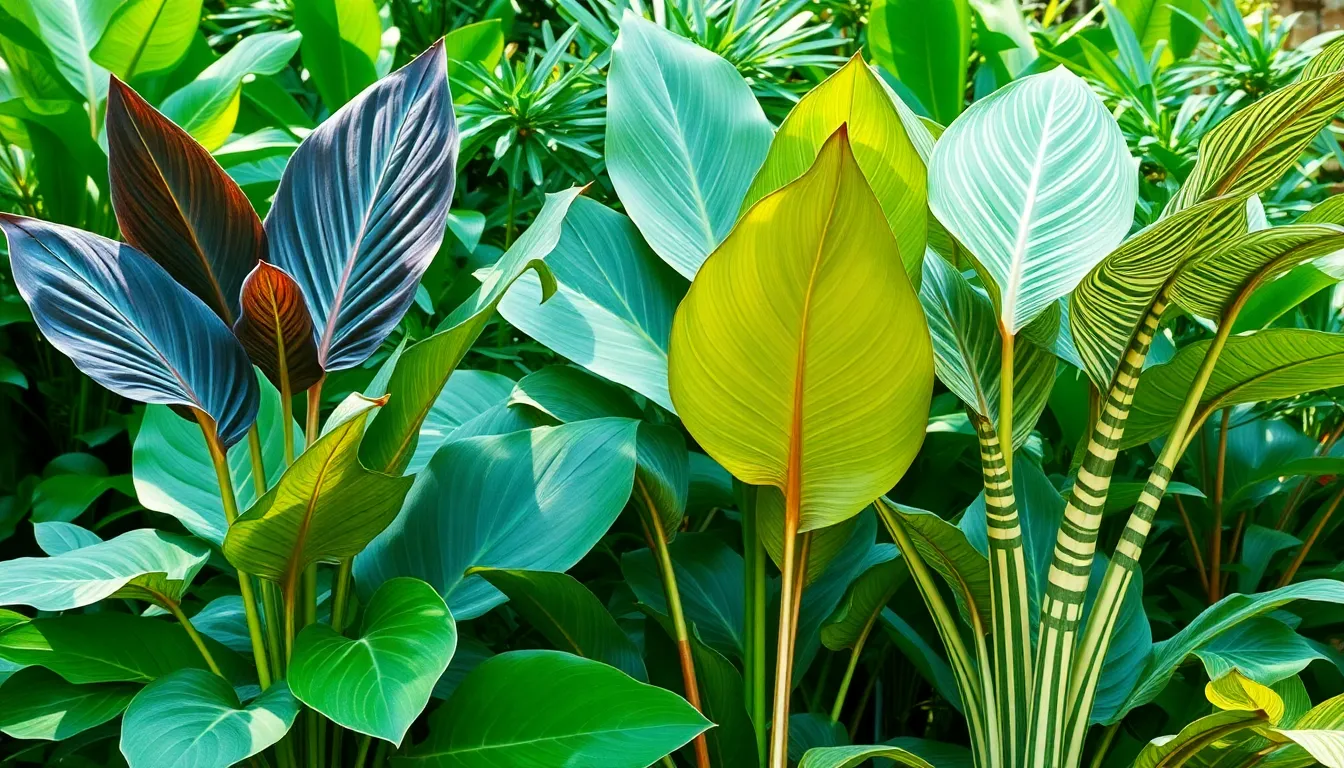
Unlike their Colocasia cousins that gracefully droop downward, Alocasia varieties distinguish themselves with leaves that reach proudly skyward. We’ve selected these remarkable upward-facing elephant ears for their architectural presence and stunning visual impact.
Alocasia Amazonica (African Mask Plant)
Alocasia Amazonica captivates gardeners with its dramatic dark green foliage and striking purple undersides. Native to Asia, this showstopper can grow between 2-10 feet tall, making it perfect for creating bold focal points in your industry design. We love how the glossy surface reflects light while the deep purple backing adds unexpected color depth.
Growing conditions for this beauty require exact attention to detail. Bright, indirect light provides the perfect environment, while high humidity levels keep the foliage looking its best. Well-draining soil prevents root rot, and maintaining temperatures above 60°F (15°C) ensures healthy growth throughout the growing season.
Alocasia Macrorrhizos (Giant Taro)
Alocasia Macrorrhizos lives up to its “giant” reputation with massive heart-shaped leaves that command attention. This variety has served as both ornamental plant and food source across various cultures, demonstrating its versatility beyond garden aesthetics. We appreciate how its substantial size creates instant tropical ambiance in larger garden spaces.
Cultivation requirements mirror other Alocasia varieties but on a grander scale. The impressive foliage demands consistent moisture and protection from harsh winds that could damage the large leaves. Spacing becomes crucial with this giant, as mature plants need room to showcase their full magnificent spread.
Alocasia Zebrina (Zebra Plant)
Alocasia Zebrina stands out with its distinctive striped stems that resemble zebra patterns. The prominent leaf veins create additional visual texture, making this variety a conversation starter in any garden setting. We find the unique patterning adds an exotic element that complements both modern and traditional industry designs.
Care requirements follow the standard Alocasia protocol with emphasis on consistent conditions. Bright, indirect light prevents leaf scorching while maintaining the vibrant patterns. High humidity levels keep the distinctive markings crisp and clear, ensuring this zebra-striped beauty maintains its stunning appearance throughout the growing season.
Xanthosoma Varieties: The Arrow-Shaped Beauties
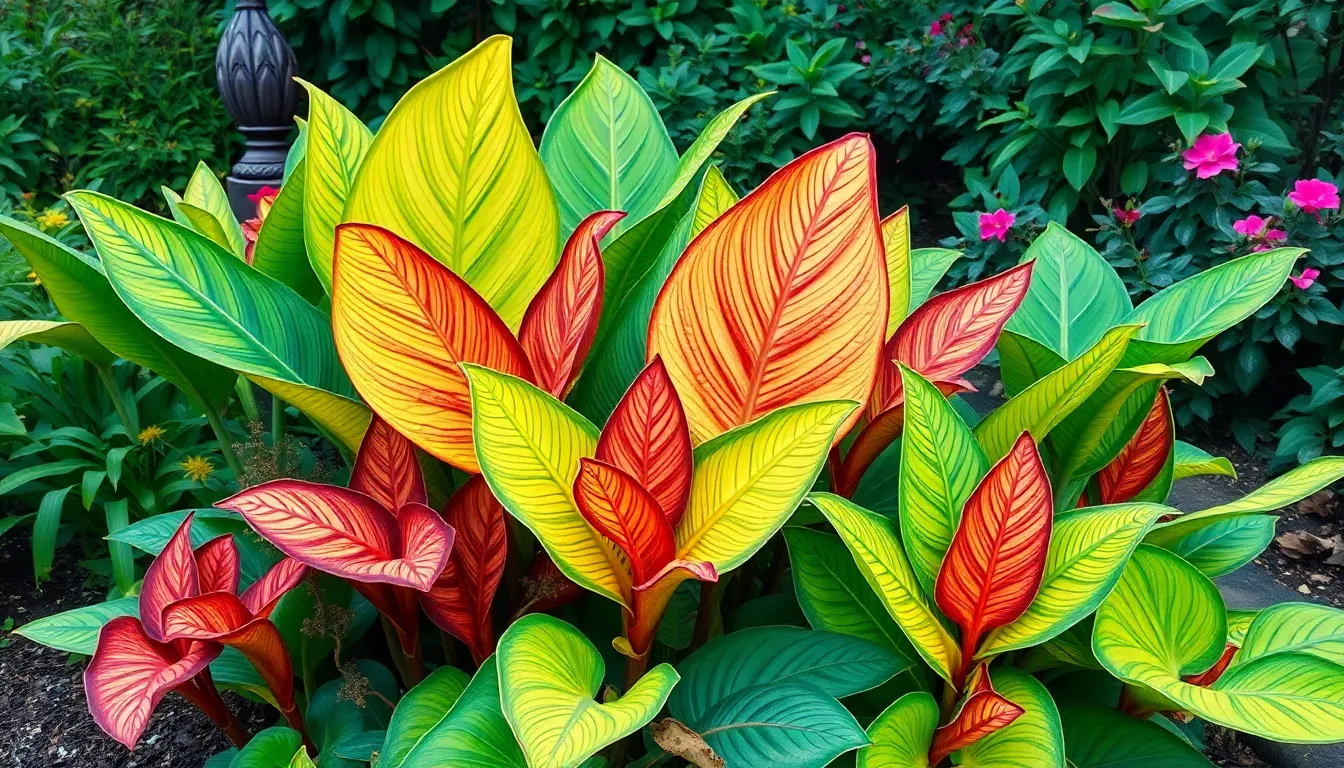
We discover stunning visual appeal in Xanthosoma species, which feature distinctive arrow-shaped foliage that sets them apart from other elephant ear varieties. These tropical flowering plants offer unique leaf formations and exceptional growing characteristics that make them prized additions to any garden design.
Xanthosoma Sagittifolium (White Yautia)
Arrowleaf elephant ear stands out as the most recognizable Xanthosoma variety with its distinctive arrow-shaped leaves that create dramatic focal points in garden landscapes. We appreciate this tropical flowering plant for its reliable growth pattern and adaptable nature in various growing conditions. Gardeners often choose White Yautia for its consistent performance in both container cultivation and ground plantings. The species thrives in rich, moist soil conditions while tolerating partial shade environments effectively. Mature plants develop impressive foliage displays that complement other tropical species beautifully. We recommend this variety for gardeners seeking dependable elephant ear performance with striking leaf architecture.
Xanthosoma Violaceum (Blue Taro)
Vibrant coloration makes Blue Taro a sought-after choice among elephant ear enthusiasts who desire unique purple hues in their garden designs. We observe that this variety’s foliage often displays purple tones rather than true blue coloration, creating striking visual contrasts in tropical plantings. The species requires similar growing conditions to other Xanthosoma varieties but offers exceptional ornamental value through its distinctive color palette. Gardeners appreciate Blue Taro’s ability to maintain its vibrant hues throughout the growing season when provided with adequate moisture and partial shade protection. We find this variety particularly effective in creating dramatic color schemes when paired with green-leafed elephant ear companions.
Xanthosoma Lindenii (Indian Kale)
Traditional cuisine applications have made Indian Kale notable among Xanthosoma varieties, though we also value its ornamental characteristics in garden settings. This variety offers unique leaf formations that differ from other elephant ear species while maintaining the characteristic arrow-shaped profile. We observe that Indian Kale adapts well to various growing conditions and provides consistent foliage displays throughout the season. The species contributes both aesthetic and practical value to gardens where edible landscaping concepts are implemented. Gardeners benefit from Indian Kale’s dual-purpose nature, enjoying both its visual appeal and potential culinary applications when properly cultivated.
Caladium Cultivars: The Colorful Heart-Shaped Options
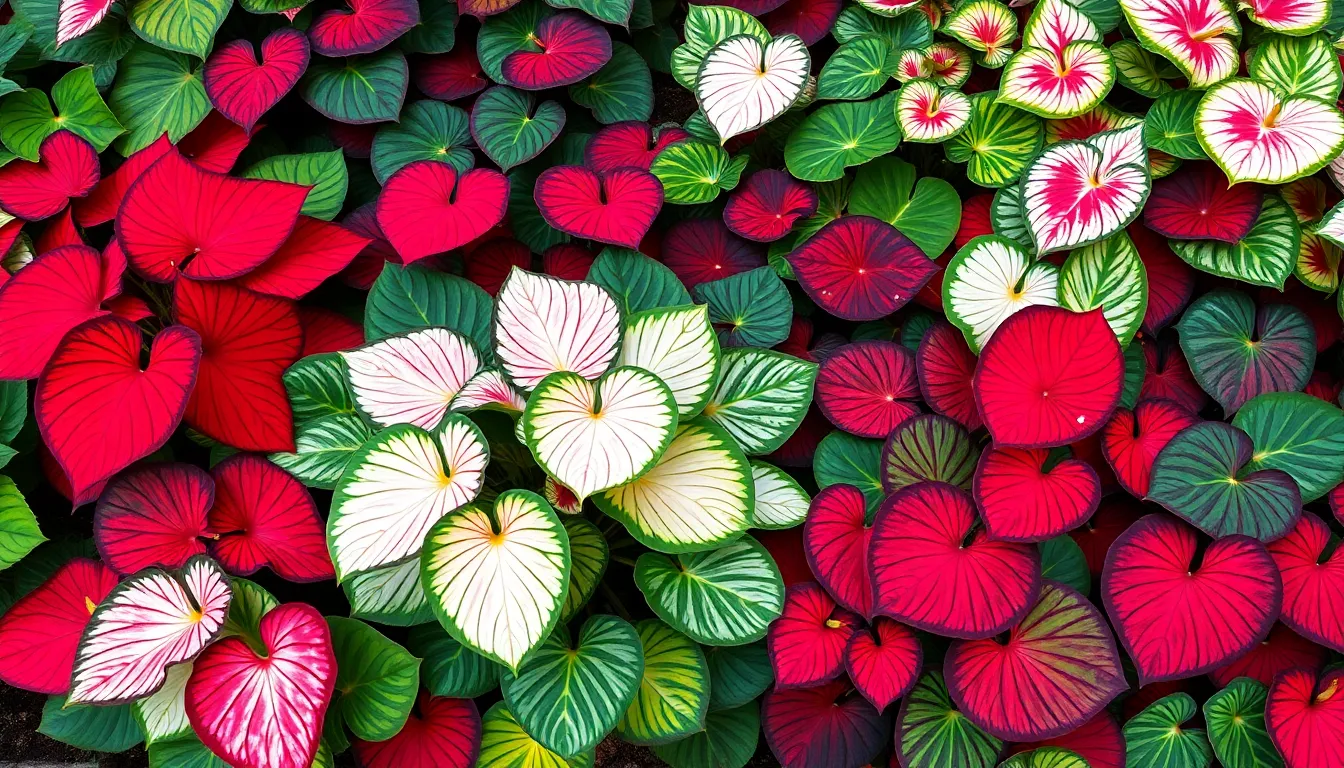
Caladium bicolor stands out among elephant ear varieties for its vibrant heart-shaped leaves that display striking color combinations. These cultivars offer hundreds of unique options with patterns and colors including green, white, pink, and red blotching.
Caladium Bicolor Varieties
Fancy-leafed varieties dominate the Caladium bicolor collection with their large heart-shaped leaves and diverse patterns. These cultivars showcase mottled, veined, and striped designs that create stunning visual displays in both indoor and outdoor settings.
Red Flash delivers dramatic appeal with its dark red leaves featuring pink spots and wide dark green margins. This cultivar creates bold contrast in shaded garden areas and container arrangements.
Rosebud presents a softer aesthetic with its pink center surrounded by white coloration and green edges. We find this variety particularly effective for creating romantic garden themes and gentle color transitions.
White Christmas brightens any space with its bright white leaves accented by dark green veins and margins. This cultivar provides excellent contrast against darker foliage plants and works well in moonlight gardens.
White Queen offers elegance through its pure white leaves enhanced by thin red and green veins. The delicate vein patterns create intricate natural artwork that draws attention without overwhelming other plants.
Thai Beauty Caladium
Thai Beauty Caladium showcases beautiful heart-shaped leaves with intricate patterns that exemplify the artistry of Caladium breeding. This cultivar combines multiple colors in complex designs that change subtly as the plant matures throughout the growing season.
Pattern complexity makes Thai Beauty particularly valuable for collectors seeking unique elephant ear varieties. We recommend this cultivar for gardeners who appreciate detailed foliage and want conversation pieces in their plant collections.
Moonlight Caladium
Moonlight Caladium provides softer, more pastel coloration compared to the bold statements of other Caladium varieties. This cultivar offers gentle color transitions that complement rather than compete with surrounding plants.
Pastel tones make Moonlight particularly suitable for subtle garden designs and indoor displays where harsh colors might overwhelm the space. We find this variety excellent for creating calming environments and sophisticated color schemes in tropical and subtropical plantings.
Begonia Rex: The Textured Alternative Elephant Ear
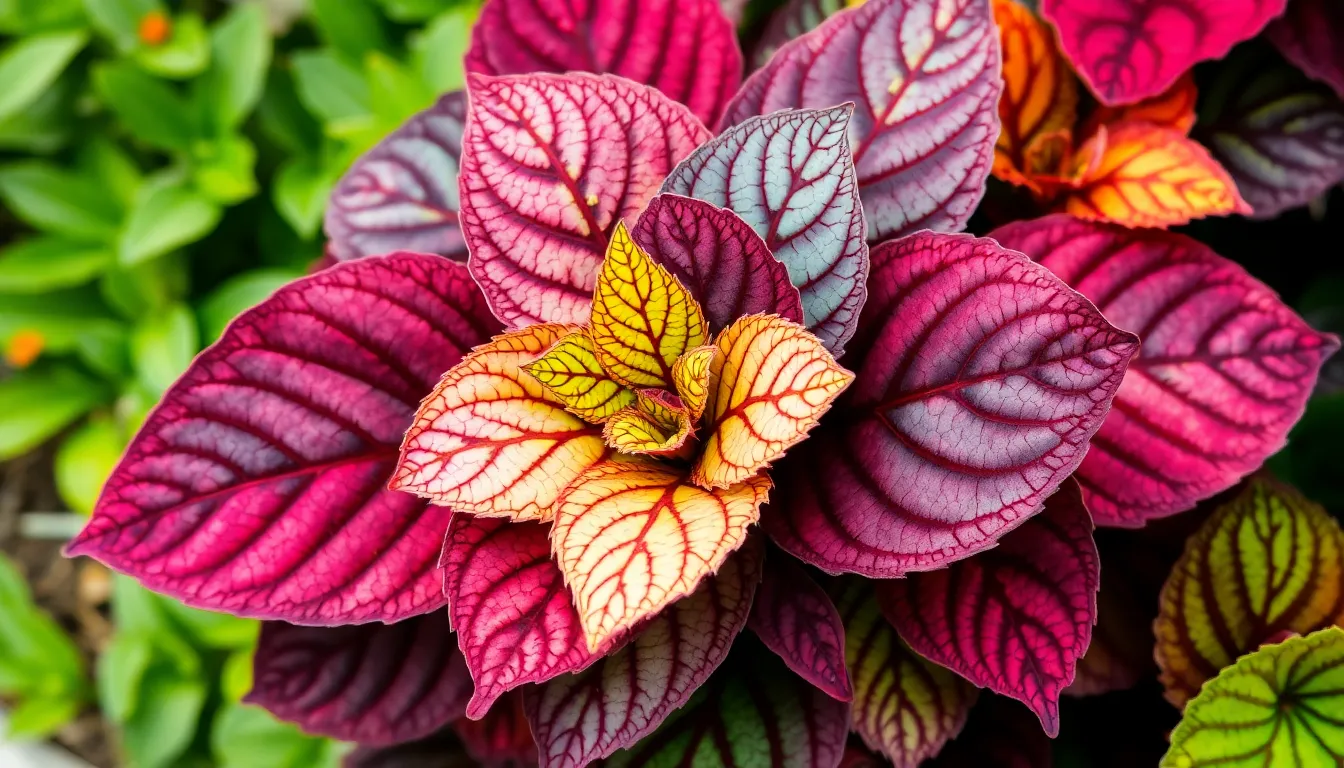
While traditional elephant ears captivate with their massive foliage, Begonia Rex offers a unique textured alternative that brings intricate patterns and compact beauty to our gardens.
Begonia Rex Leaf Patterns
Striking variations define Begonia Rex leaves, which showcase an impressive range of colors and patterns that rival any traditional elephant ear. Textural diversity sets these plants apart, with leaves displaying smooth, crinkled, or velvety surfaces that create visual depth in our plantings.
Color combinations range from deep burgundy and silver to bright green with metallic accents, often appearing in swirled or banded patterns across each leaf. Pattern complexity varies dramatically between cultivars, with some featuring bold geometric designs while others display subtle color gradations.
Leaf dimensions typically reach 9 inches long and 5 inches wide, making them perfect for smaller spaces where larger elephant ears might overwhelm. Plant height remains manageable at 12 to 18 inches, allowing us to incorporate these textured beauties into front borders and container arrangements.
Flowering characteristics include small pink to white blooms, though these delicate flowers often take a backseat to the spectacular foliage display that makes Begonia Rex so desirable.
Care Requirements for Rex Begonias
Monthly fertilization during the growing season keeps Rex Begonias thriving, using a balanced water soluble fertilizer to support their vibrant leaf development. Winter feeding should be reduced as growth naturally slows during cooler months.
Regular maintenance involves removing yellowing or dead leaves promptly to maintain plant health and visual appeal. Fallen leaves must be cleared from the soil surface to prevent disease development that could compromise our plants.
Pest monitoring becomes especially important when moving plants indoors, as spider mites, aphids, and mealy bugs commonly target Rex Begonias during seasonal transitions. Weekly inspections help us catch infestations early before they damage the prized foliage.
Humidity management proves crucial for optimal leaf texture development, as these plants thrive in environments with consistent moisture levels that support their unique surface characteristics.
Philodendron Gloriosum: The Velvety Elephant Ear Look-Alike
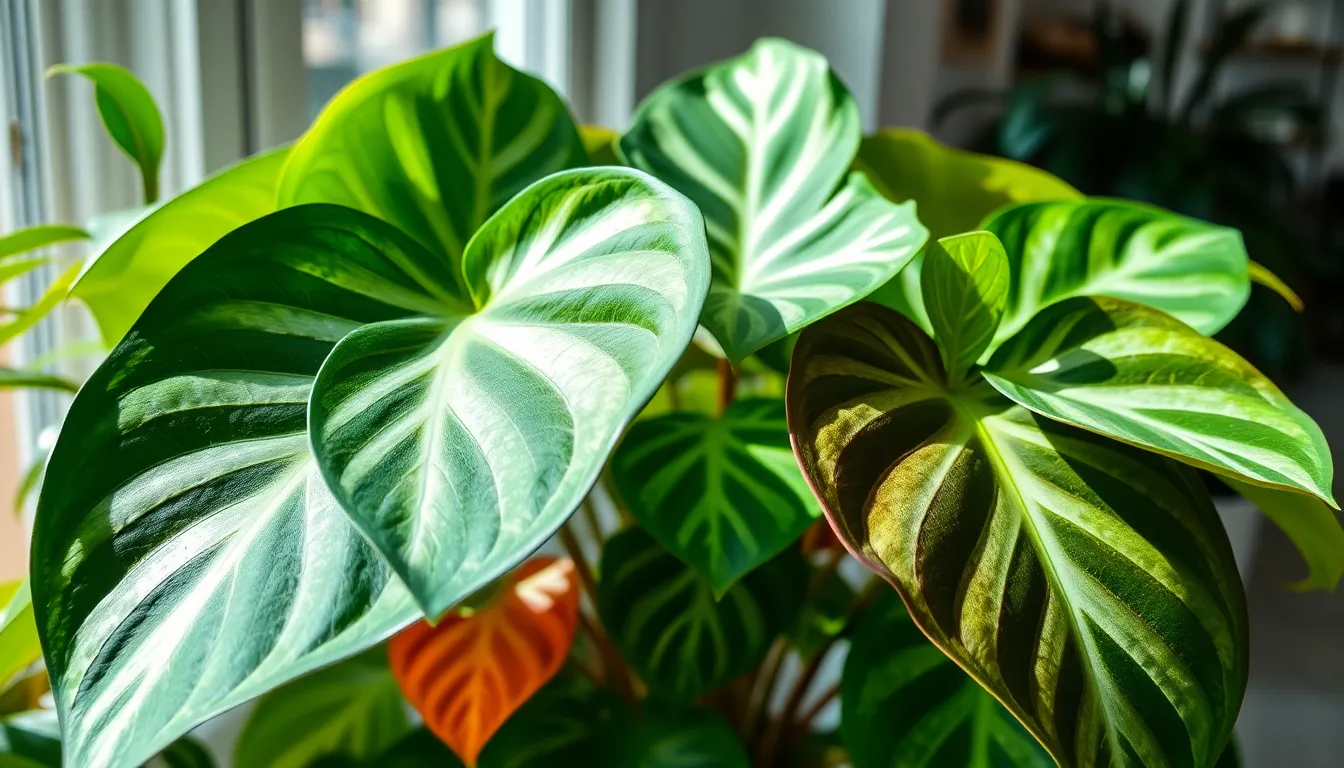
While Philodendron Gloriosum isn’t technically an elephant ear plant, its stunning appearance often leads gardeners to group it with these beloved foliage specimens. This creeping velvet philodendron brings the same dramatic visual impact we seek from traditional elephant ear varieties.
Distinctive Heart-Shaped Foliage
Large heart-shaped leaves define Philodendron Gloriosum’s striking appearance, measuring several inches across with a luxurious velvety texture that sets it apart from glossy philodendron varieties. The deep green foliage showcases pronounced silver-white veining that creates intricate patterns across each leaf surface, giving this plant its signature elegant look.
Velvety texture creates a soft, almost suede-like feel when you gently touch the leaves, making this philodendron particularly appealing for indoor plant enthusiasts who appreciate tactile experiences. The matte finish of the foliage provides a sophisticated contrast to shinier houseplants in your collection.
Silver-white veining forms bold, prominent lines that radiate from the leaf base, creating natural artwork on each individual leaf. These striking veins become more pronounced as the plant matures, developing into one of the most recognizable features of this philodendron variety.
Growing Conditions and Maintenance
Bright indirect light provides the optimal growing environment for Philodendron Gloriosum, helping maintain the vibrant green coloration and prominent veining without causing leaf burn. Direct sunlight can damage the delicate velvety surface, so we recommend placing it near east or north facing windows.
Well-draining aroid potting mix ensures proper root health while preventing the waterlogged conditions that can quickly kill this moisture sensitive plant. A mixture containing perlite, orchid bark, and quality potting soil creates the chunky, breathable environment these plants prefer.
High humidity levels over 50% support healthy leaf development and prevent the brown, crispy edges that indicate inadequate moisture in the air. Using a humidifier or placing the plant on a pebble tray filled with water helps maintain these tropical conditions indoors.
Consistently moist soil keeps Philodendron Gloriosum thriving, but overwatering sensitivity means we must allow the top inch of soil to dry between waterings. This climbing philodendron can reach up to 2.5 feet tall when provided with proper support and care, making it an impressive addition to any plant collection even though its low maintenance requirements.
Anthurium Magnificum: The Rare Collector’s Choice
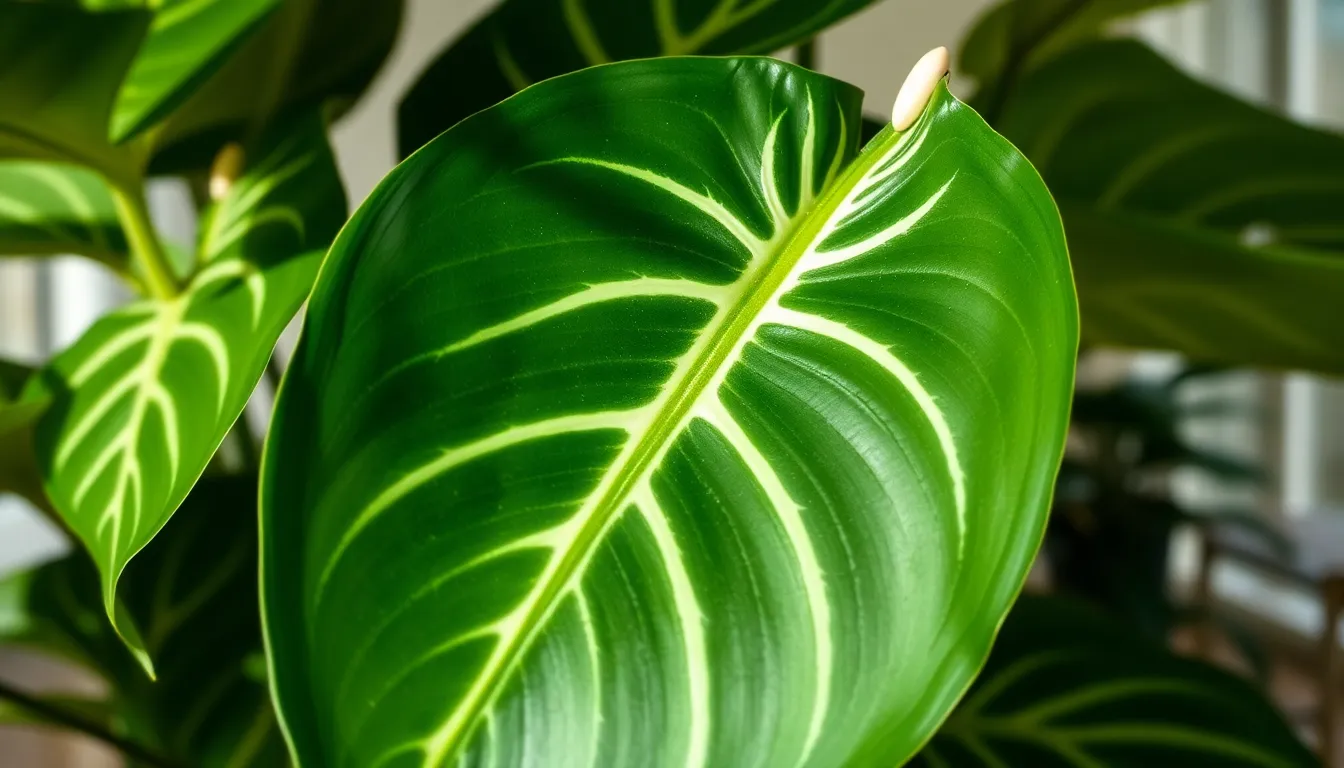
While we’ve explored traditional elephant ear plants, Anthurium Magnificum stands apart as a premium tropical specimen that collectors prize for its extraordinary beauty. This Colombian native brings an entirely different aesthetic to the elephant ear family with its sophisticated appearance and luxurious texture.
Unique Leaf Characteristics
Velvety surfaces distinguish Anthurium Magnificum from other elephant ear varieties, creating a tactile experience that’s unlike any traditional Alocasia or Colocasia. The deep dark green foliage develops a rich, mature coloration that intensifies as each leaf reaches full size.
Prominent white or silver veins create stunning contrast against the dark leaf surface, often sparkling when light hits them at the right angle. These veins are more pronounced than those found in typical elephant ears, giving each leaf an almost metallic quality.
Heart shaped formation appears less pronounced than Anthurium clarinervium but maintains the classic cordate structure that elephant ear enthusiasts love. The leaves can reach impressive sizes while maintaining their elegant proportions and sophisticated appearance.
Leaf texture remains consistently velvety throughout the growing season, requiring minimal maintenance to preserve its luxurious feel. This characteristic makes Anthurium Magnificum particularly appealing for indoor displays where people can appreciate its unique tactile qualities.
Propagation Methods
Division techniques work best for established Anthurium Magnificum plants, allowing us to carefully separate healthy root systems during repotting periods. We recommend performing divisions during spring when the plant shows active growth signs.
Root separation requires gentle handling to preserve the delicate root structure that supports those magnificent leaves. Clean, sharp tools help prevent damage during the division process, ensuring each new plant has adequate root mass for independent growth.
Stem cutting methods involve selecting healthy stems with visible nodes, cutting just above each node to encourage new growth development. This technique works particularly well when the parent plant has developed multiple growing points.
Propagation success depends heavily on maintaining proper humidity levels around 70% and providing bright, indirect light throughout the rooting period. We’ve found that using well draining, organic soil mixtures significantly improves establishment rates for new divisions and cuttings.
Indoor vs Outdoor Elephant Ear Varieties
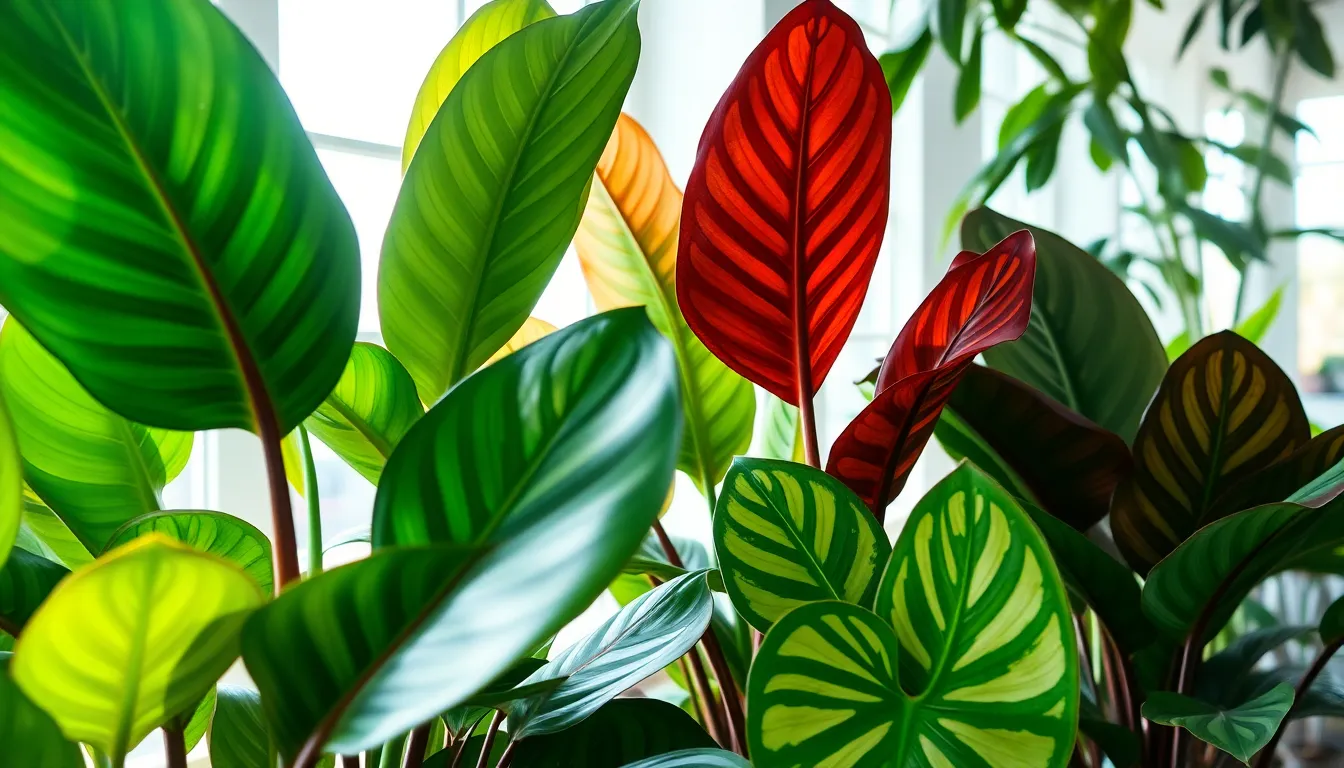
Choosing between indoor and outdoor elephant ear varieties depends on your space limitations and climate conditions. We’ll explore the best options for both settings to help you make the perfect selection.
Best Varieties for Houseplants
Colocasia esculenta stands out as our top indoor choice for its distinctive matte finish and adaptable nature. This versatile variety thrives in container settings when provided with bright, indirect light and consistent moisture levels.
Colocasia heterochroma ‘Dark Shadows’ offers compact beauty at just 8 inches tall, making it perfect for smaller indoor spaces. We recommend this variety for beginners since it’s easy to manage and can be successfully moved indoors before frost to protect against freezing temperatures.
Mojito Elephant Ear brings unique visual interest with its speckled foliage pattern that creates stunning focal points in any room. This newer variety performs exceptionally well in containers and tolerates partial shade conditions common in indoor environments.
| Indoor Variety | Height | Light Requirements | Special Features |
|---|---|---|---|
| Colocasia esculenta | Variable | Bright, indirect | Matte finish leaves |
| Dark Shadows | 8 inches | Moderate to bright | Compact size |
| Mojito | Medium | Partial shade tolerant | Speckled foliage |
Hardy Outdoor Elephant Ear Options
Colocasia esculenta proves its versatility by excelling outdoors in warmer climates where it can reach its full potential. This common variety establishes quickly in garden beds and provides reliable performance season after season.
Colocasia gigantea delivers dramatic impact with its massive leaves that thrive in full sun exposure. We’ve found this variety requires consistent moisture and warm temperatures to achieve its impressive size potential.
Alocasia odora commands attention as the Upright Elephant Ear, preferring partial shade conditions and steady water supply. This variety’s vertical growth habit makes it ideal for creating height variation in outdoor plantings.
Black Coral from the Royal Hawaiian series showcases large, glossy, all-black leaves that create striking contrasts in sunny garden locations. We recommend this variety for gardeners seeking bold, dramatic foliage that maintains its color intensity throughout the growing season.
Dwarf Elephant Ear Varieties for Small Spaces
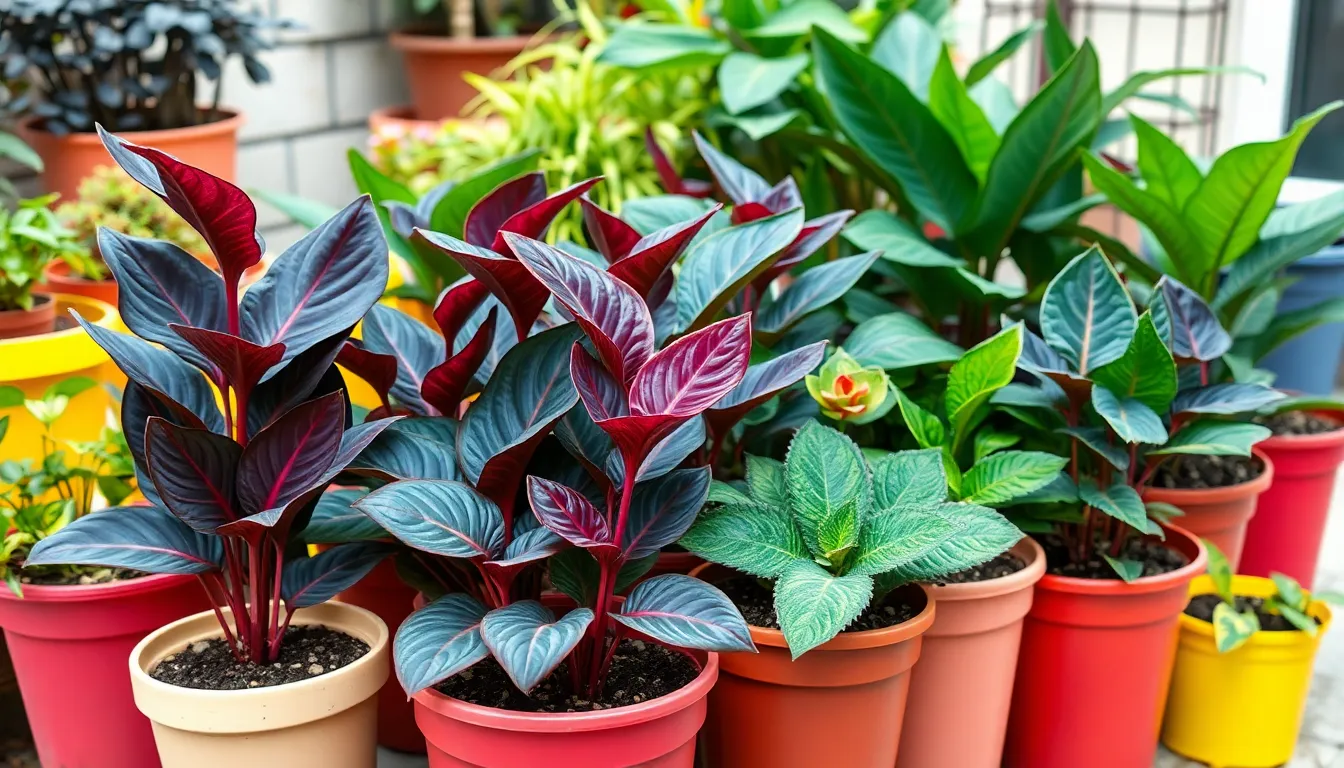
We’ve discovered exceptional dwarf elephant ear varieties that perfectly complement small gardens and tight spaces. Compact growth habits make these varieties ideal for urban gardens, small patios, and indoor containers.
Compact Colocasia Options
Midnight Elephant Ear transforms small spaces with its dramatic deep purple-black leaves that reach 2-3 feet in height. This stunning Colocasia esculenta variety features matching dark petioles that create a cohesive, bold appearance throughout the growing season.
Colocasia affinis delivers unique charm for gardeners seeking less common varieties in compact sizes. We recommend planting these attractive specimens en masse for maximum visual impact in small garden beds.
Colocasia fallax provides another excellent option for those wanting distinctive dwarf varieties with manageable dimensions. Both C. affinis and C. fallax offer reliable performance in limited spaces while maintaining the classic elephant ear appeal.
Colocasia gigantea surprises gardeners with available dwarf forms even though its species name suggesting large size. These compact versions retain the species’ attractive characteristics while fitting comfortably in smaller garden areas.
Colocasia heterochroma rounds out our selection with unique color variations that add visual interest to tight spaces. This variety’s compact nature makes it perfect for container cultivation or as accent plants in small landscapes.
Container-Friendly Alocasia Types
Alocasia Tiny Dancer lives up to its name by growing only 12-15 inches tall with slender stems and petite green leaves. This compact variety thrives in indirect light conditions, making it perfect for indoor containers or shaded outdoor spots.
Alocasia Bambino creates stunning displays in containers under a foot tall, featuring distinctive reddish stems and dark green leaves with striking ivory veins. We’ve found this variety performs exceptionally well in moderate shade conditions.
Alocasia Frydek captivates with its velvety texture and distinctive arrowhead-shaped leaves adorned with cream-colored veins. This variety requires bright, indirect light indoors and adapts beautifully to container cultivation.
Dwarf Amazonica Elephant Ear offers classic appeal in a smaller package, requiring the same warmth, humidity, and consistent moisture as its larger counterparts. This compact version maintains the beloved Amazonica characteristics while fitting perfectly in container gardens.
Giant Elephant Ear Varieties for Statement Gardens
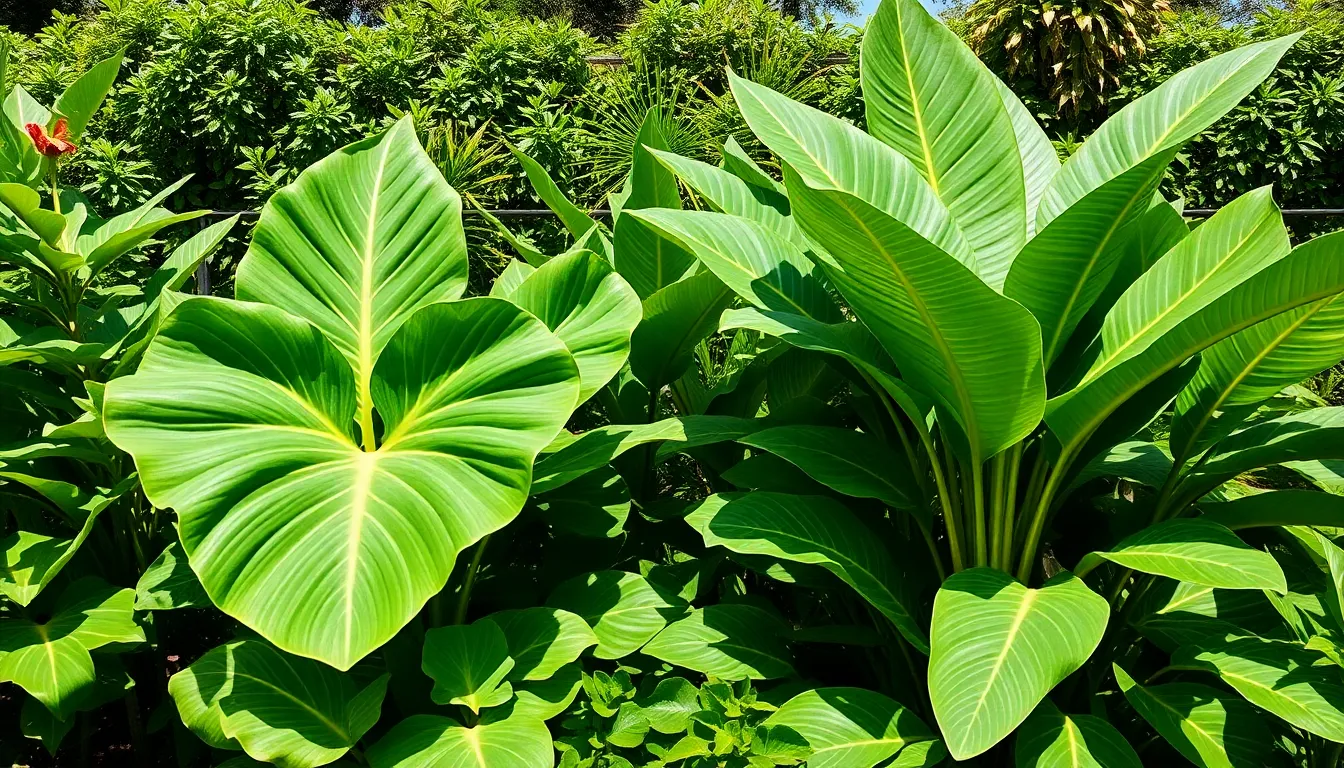
When we want to create dramatic focal points in our landscapes, giant elephant ear varieties deliver unmatched visual impact with their massive foliage and bold presence.
Colocasia Gigantea Features
Colocasia gigantea stands as the ultimate showstopper among elephant ear varieties, producing leaves that can reach extraordinary dimensions of up to 6 feet in length. This impressive specimen thrives in full sun conditions where it can achieve its maximum growth potential and develop its characteristic thick, sturdy stems.
We’ve observed that this variety requires consistently moist soil conditions to support its massive leaf production, making it perfect for poolside plantings or near water features. The heart shaped leaves display a rich green color with prominent veining that creates stunning textural interest throughout the growing season.
Growing heights can reach 8 to 10 feet tall in optimal conditions, making Colocasia gigantea an excellent choice for creating natural privacy screens or backdrop plantings. The plant’s robust root system spreads gradually, establishing strong colonies that return reliably each season in warmer climates.
Maintenance involves regular watering during dry periods and monthly fertilization with balanced nutrients to support the enormous leaf development. We recommend providing wind protection for the largest specimens to prevent leaf damage from strong gusts.
Alocasia Odora Characteristics
Alocasia odora, commonly known as Upright Elephant Ear, distinguishes itself through its distinctive upward facing leaf orientation that creates vertical drama in garden designs. This variety typically reaches heights of 4 to 8 feet with leaves measuring 2 to 4 feet in length, making it more manageable than its Colocasia counterparts.
The glossy green foliage maintains an arrow like shape with pronounced veining that catches and reflects light beautifully throughout the day. We’ve found this variety particularly effective in partial shade locations where other elephant ears might struggle to maintain their vibrant appearance.
Growing from bulb structures rather than rhizomes, Alocasia odora establishes quickly in well draining soil with consistent moisture levels. The plant prefers bright, indirect light conditions and benefits from high humidity environments that support optimal leaf development.
Winter care involves protecting the bulbs in colder climates or bringing container grown specimens indoors where they can continue growing as houseplants. We recommend checking soil moisture regularly since this variety shows stress quickly when conditions become too dry or waterlogged.
Propagation occurs naturally through offset bulbs that develop around the main plant, allowing us to expand our collections or share with fellow gardeners who appreciate these stunning tropical specimens.
Conclusion
We’ve explored an incredible array of elephant ear varieties that can transform any garden space. From the dramatic black foliage of Black Magic to the delicate patterns of Caladium cultivars each variety offers unique characteristics to suit different growing conditions and design preferences.
Whether you’re working with compact indoor spaces or expansive outdoor gardens there’s an elephant ear variety that’ll meet your needs. The diversity spans from towering giants like Colocasia gigantea to charming dwarf varieties perfect for containers.
These remarkable plants prove that gardening success comes from matching the right variety to your exact conditions. With proper care and thoughtful selection elephant ears can become stunning focal points that bring tropical beauty to gardens across different climates and spaces.
Frequently Asked Questions
What are elephant ear plants and why are they popular?
Elephant ear plants are tropical foliage plants known for their large, heart-shaped leaves that dramatically enhance garden aesthetics. They’re popular because of their diverse range of species including Colocasia, Alocasia, and Xanthosoma varieties, each offering unique characteristics from classic green to vibrant purple and nearly black leaves. These plants create stunning focal points in both indoor and outdoor settings.
What’s the difference between Colocasia, Alocasia, and Xanthosoma varieties?
Colocasia varieties have downward-facing leaves and include popular options like Black Magic with deep purple foliage. Alocasia species feature upward-facing leaves, such as Alocasia Amazonica with striking purple undersides. Xanthosoma varieties are distinguished by their arrow-shaped foliage, like Xanthosoma Sagittifolium (White Yautia) known for reliable growth and adaptability.
Which elephant ear varieties work best indoors?
For indoor growing, Colocasia esculenta adapts well with its matte finish leaves, while Colocasia heterochroma ‘Dark Shadows’ is perfect for smaller spaces due to its compact size. Mojito Elephant Ear offers unique speckled foliage that adds visual interest indoors. These varieties thrive in bright, indirect light with consistent moisture and high humidity levels.
What are the best giant elephant ear varieties for dramatic landscaping?
Colocasia gigantea produces the largest leaves, reaching up to 6 feet long, and thrives in full sun with consistently moist soil. Alocasia odora features upward-facing leaves with manageable height, making it suitable for partial shade areas. Both varieties create excellent focal points and natural privacy screens in landscape designs.
Which dwarf elephant ear varieties are ideal for small spaces?
Compact Colocasia options include Midnight Elephant Ear, Colocasia affinis, and Colocasia fallax, which maintain classic appeal in limited areas. Container-friendly Alocasia types like Alocasia Tiny Dancer, Alocasia Bambino, and Alocasia Frydek thrive in smaller settings. These dwarf varieties are perfect for urban gardens, small patios, and indoor containers.
What are Caladium varieties and how do they differ from other elephant ears?
Caladium bicolor varieties are celebrated for vibrant heart-shaped leaves with diverse color combinations including green, white, pink, and red patterns. Popular varieties include Red Flash with dark red leaves, White Queen with striking white foliage, and Moonlight Caladium with pastel tones. They’re ideal for both indoor and outdoor decorative purposes.
How do I care for exotic elephant ear alternatives like Philodendron Gloriosum?
Philodendron Gloriosum features large heart-shaped leaves with velvety texture and silver-white veining. It thrives in bright indirect light, requires well-draining soil, and needs high humidity levels. Maintain consistent moisture while avoiding overwatering. This climbing variety can reach 2.5 feet tall, making it an impressive addition to plant collections.
What growing conditions do elephant ear plants require?
Most elephant ear varieties need consistently moist soil, high humidity, and protection from harsh winds. Colocasia varieties typically prefer partial shade to full sun, while Alocasia species thrive in bright, indirect light. Regular fertilization during growing season and proper drainage are essential for healthy growth and vibrant foliage displays.

